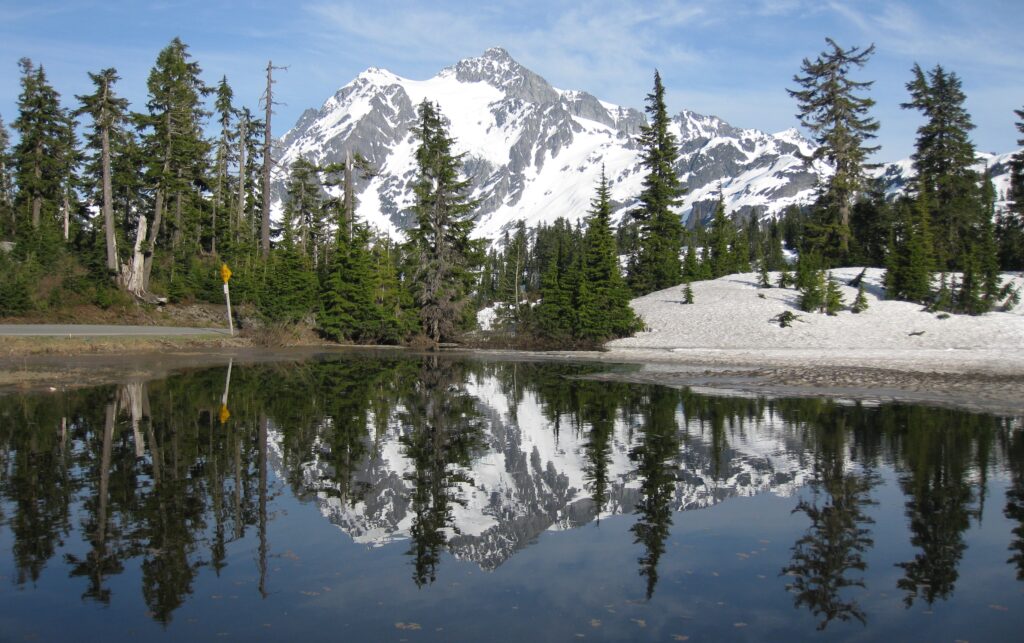
“The mountains are calling. Therefore, I must go.”
– Naturalist and conservationist John Muir
Growing up in St. Louis, Missouri in the 1970s and 1980s, I dreamed of seeing the snowcapped mountains in the western United States. Missouri has no towering snowcapped mountains, just the rolling mountains of the Ozarks. Ironically, St. Louis was the world headquarters for Anheuser Busch Beer, the largest beer company in United States. That was before it was bought out by InBev, a Belgium company in 2008. One of their flagship brands was Busch Beer. The slogan of Busch Beer was “Head for the Mountains.” As a child in St. Louis, that’s what I wanted to do. Forget the beer! I wanted to leave my hometown and head to the snowcapped mountains.
While in high school, I wanted to decorate my bedroom wall with a new poster. I asked my mom to take me to the nearby shopping mall so I could buy a poster of a majestic looking snow-capped mountain. The poster I picked was a broad sided jagged mountain with several glaciers resting on it and pockets of snow clinging to it. The mountain dominated the background of the poster. In the foreground was tall majestic bright green pine trees. A small lake was in the lower front reflecting like a perfect mirror the trees and the mountain. I stared endlessly at that poster after I hung it on my wall. I had no idea where that mountain was, but I was determined to see that mountain someday.
After I graduated from William Jewell College in May 1992, I took two different Amtrak trains Kansas City, MO to reach southern Oregon. I had a summer job at Crater Lake National Park in the gift store. I loved working and hiking at Crater Lake with the beautiful bright blue color of the lake with the snowy mountains that surrounded it. I ended up working at Crater Lake for 25 years during the summers. Crater Lake sparked a curiosity in me to see other national parks.
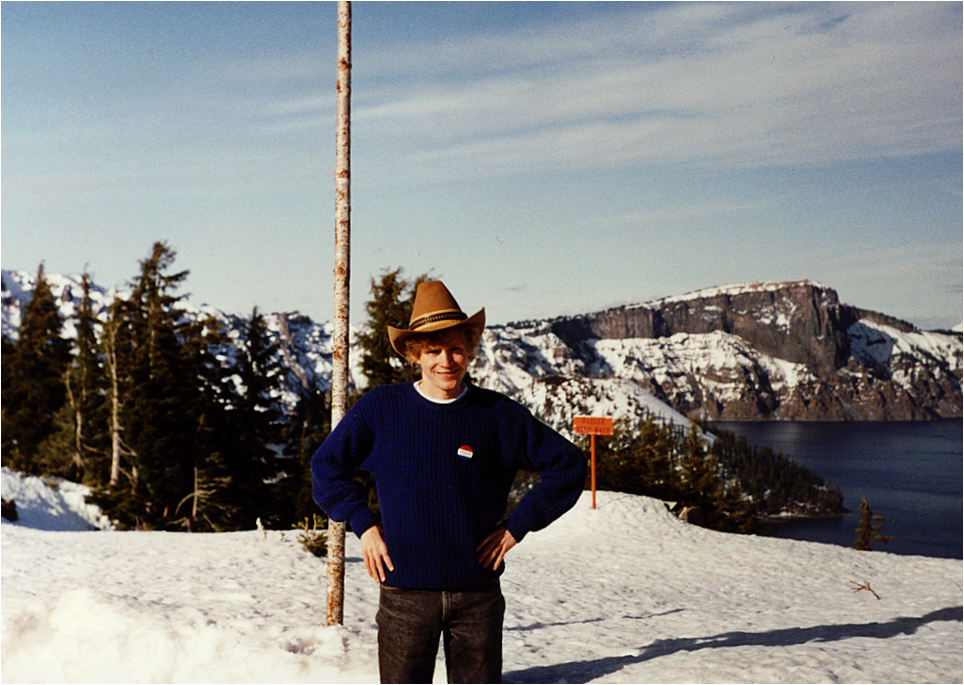
While working at the Crater Lake gift store, I thumbed through the books about other national parks hoping to visit them sometime. One day while glancing through them, I noticed a photo of Mt. Shuksan in North Cascades National Park, in Washington state. I immediately recognized Mt. Shuksan as the same mountain I had on a poster in high school. Now that I knew where that mountain was located, I was even more determined to see it someday.
My visits with friends in Salem, Oregon and Grapeview, Washington in late May 2009
In 2009, Crater Lake offered me an opportunity to work a long season from mid-March to the end of September. I would lead ranger guided snowshoe hikes for school groups from mid-March to Mid-May for the Classroom at Crater Lake program. From the second week of June until the end of September, I would then work as a seasonal interpretative ranger leading the ranger programs in the park, such as the boat tours, trolley tours, guided hikes, etc.
The catch was that because I would work a long season doing those ranger jobs, Crater Lake had to lay me off for two weeks at the last week of May and the first week of June. This prevented the park from exceeding the number of hours and weeks I could work as a seasonal employee for the federal government during a fiscal year. For this two-week vacation, I decided to visit the national parks in Washington state. This would be my chance to finally see Mt. Shuksan!
Before traveling to Washington, I spent Memorial weekend with my friends Gary and Melissa Martin and their daughter Shelby in Salem, Oregon. While visiting them, I mentioned I had never seen Silver Falls State Park, which is less than an hour drive east of Salem. It was Memorial weekend, so the park was crowded with local residents and visitors from elsewhere. We hiked the Trail of the Ten Falls. This is a loop trail over 7 miles long, with four water falls one can hike behind. The waterfalls are stunning, ranging from 27 to 178 feet. This is a state park so beautiful that it should be a national park.
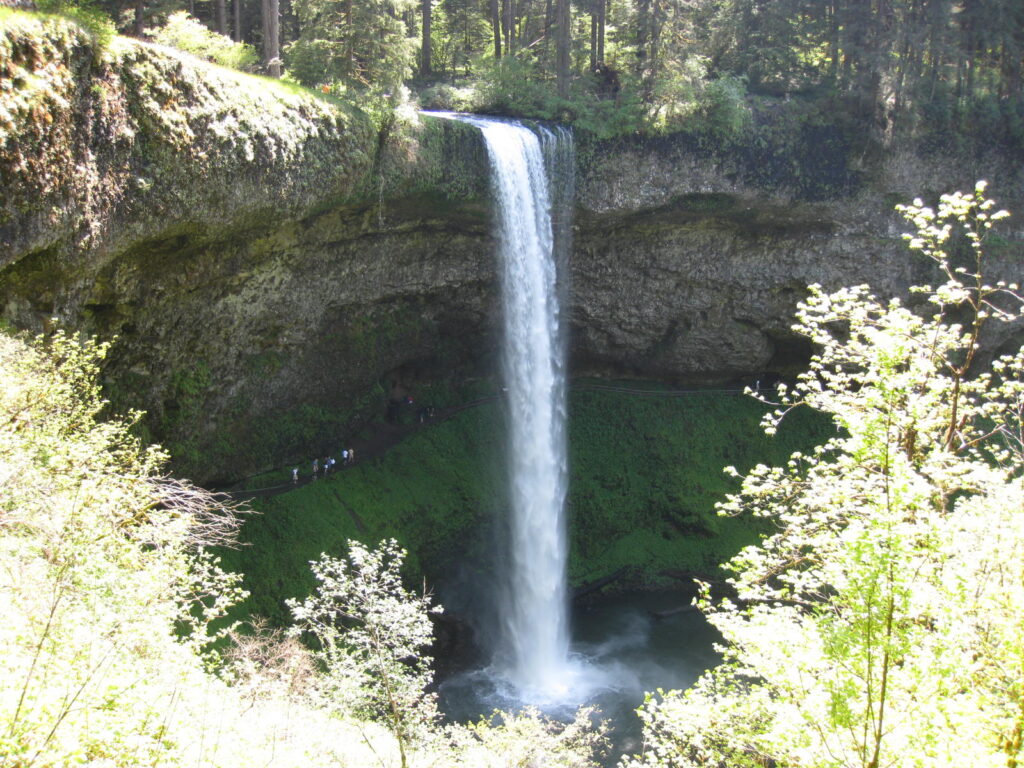
After staying with Gary and Melissa, I drove north to see my best friend, Scott Manthey, and his wife Nikki who live in Grapeview, WA. Their home is on top of a hill surrounding by other middle-class homes. On a clear day, they see Mt. Rainer to the east of them. The bottom of the hill has an inlet connecting to the southwestern end of Puget Sound. Scott and I had fun swapping music from our iTunes. Much of it was music we enjoyed listening to in high school in the 1980s.
Traveling to see Olympic National Park in late May 2009
From Scott and Nikki’s house, I started my Washington state national parks adventure. I camped for two nights at the Heart o’ the Hills Campground, just outside of Port Angeles and just inside of Olympic National Park. I figured it would be cold in late May and early June in Washington state, so I bought a cold weather sleeping bag at a nearby Wal-Mart. It turned out the I had sunny and warm weather for nearly all that trip. The next day, I returned that sleeping bag and stuck to my thinner summer sleeping bag for this vacation. I was basically by myself at this campground. The only people I saw was when I ate at a Thai restaurant in town that evening.
Later in the afternoon that day, I drove up to Hurricane Ridge to get a view of the Olympic Mountains. It was a clear day with lots of winter snow still on the mountains, which are all under 8,000 feet tall. Yet, they get hammered with snow during the winter since they reside close to the Pacific Ocean and the Strait of Juan de Fuca. The Olympics have a magnificent beauty with their snowy cragged tops. They look like the Greek Gods should be living there, not the Olympus Range in Greece, where ancient Greek mythology claim they live.
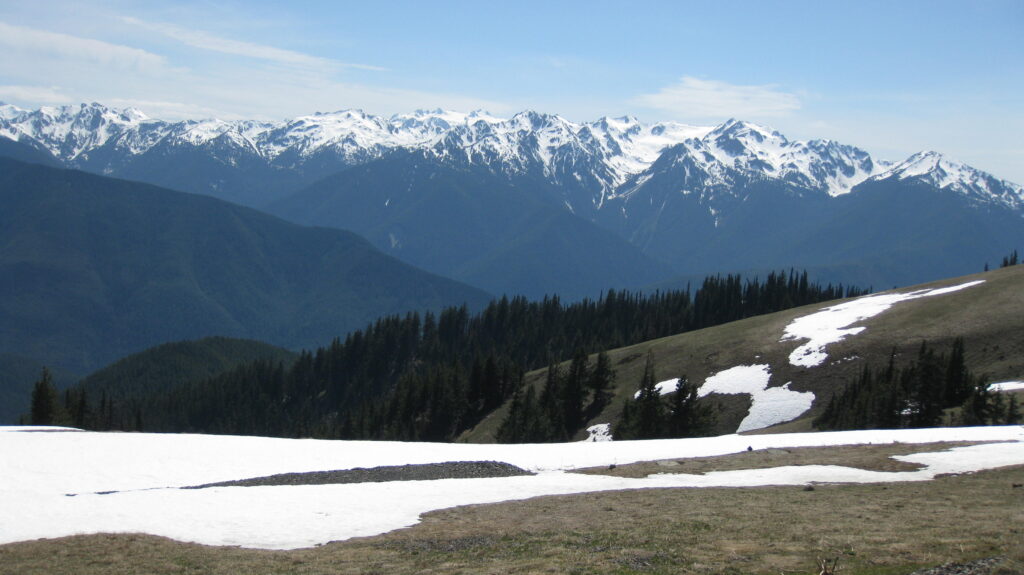
The next day, I squeezed in as much as I could to see Olympic National Park. I stopped at Elwha Valley to see Madison Water Falls and get more views of the Olympic Mountains looking up from the deep valley. I drove two hours to see the Hoh Rain Forest. I was spellbound seeing the tall and impressive Douglas Red Firs and Western Cedar providing a dark cathedral canopy for the lush ferns and forest floor plants thriving in a welcoming place of natural peacefulness.
On the drive back to Port Angeles, I traveled down a long road to see the Sol Doc Valley in the park and hike to see the roaring Sol Duc Falls. When I reached it, the waterfall looked a large concentration white water that went into a chasm next to the overlook and under the bridge that it was hard to see it all as the water pounded further down this creek in this dark forest. My final stop as daylight was almost gone was going for a half a mile hike to see Marymere Falls. It had an impressive 200 feet drop into the mossy, fern-laden ravine.
Seeing Mt. Shuksan for the first time on May 29, 2009
The next day I drove an hour and a half from the Heart O’ the Hills Campground to the seaside town of Port Townsend, the most northeastern point of the Olympic Peninsula. I then drove my car onto a crowded ferry to be shuttled across Puget Sound. As the ferry went across the open water, it seemed like the Olympics rose in height with their white snow tops to give me one final view from the west. To the east, the distant white ghost of Mt. Baker still brilliant from its winter snow started to appear more visible through the morning haze.
The ferry dropped me off at Whidbey Island. I then drove north. I was surprised by the immense scenery driving on the high bridges above Deception Pass. I stopped my car for a while to admire and photograph the bridges, the spring flowers, and the distant Olympic Mountains. I walked on the bridges with heavy traffic driving by. I wanted to get a look at how the bridges separate the ocean waters of Strait of Juan de Fuca (to the west) to Skagit Bay (to the east).
I then east drove to Sedro-Woolley to say hello to a ranger I knew at the North Cascades Visitor Center. From there, I drove straight north on Hwy 9. Just south the town of Acme, Washington around 2:30 pm, I slammed on the brakes. To the east, I could see these majestic jagged snowcapped mountains of the Twin Sisters Range. I was getting excited because the weather might be clear enough to drive up to see Mt. Shuksan.
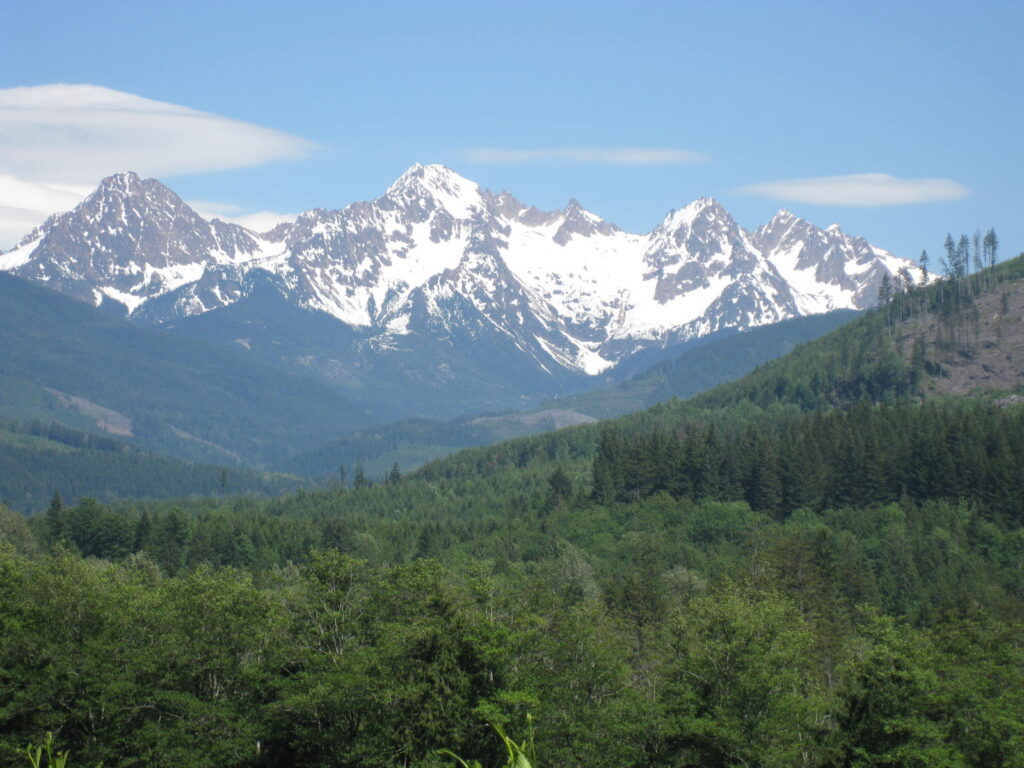
I eagerly drove my car north to Maple Falls, Washington, which is just a few miles south of the Canadian border. I then headed east on Highway 540. Just outside of Glacier, Washington, I found a Forest Service Campground, the Douglas Fir Campground, nearly empty where I quickly pitched my tent for the night. I then drove up this very windy highway with some of the sharpest hairpin turns and switchbacks to the top to the Mt. Baker Ski Area.
At 5:50 pm, the sky was bright blue with no clouds in the sky. I rounded the bend entering the Mt. Baker Ski Area, also known as Heather Meadows. No cars were in sight. Ski season was over. The only sound was the light whistle of the wind. I was completely alone. My first sight of Mt. Shuksan stunned me. It was the most beautiful natural wonder I had seen in my life.
The heavy winter snowpack clung deeply to mountain. The late afternoon sun shining on the mountain made it nearly glow with illumination. The real sight of Mt. Shuksan was much more splendid to see in person. The deep dark rocks of the mountain that jutted out in between the to a pointy triangular top gave the mountain a towering appearance.
Naturalist and conservationist John Muir, who is known as “The Father the National Parks” wrote over 100 years ago, “Thousands of tired, nerve-shaken, over-civilized people are beginning to find out that going to the mountains is going home.”
It felt like Mt. Shuksan said to me, ‘Welcome home, Brian! It took you long enough to get here. You had that poster on your bedroom wall over 22 years ago.’
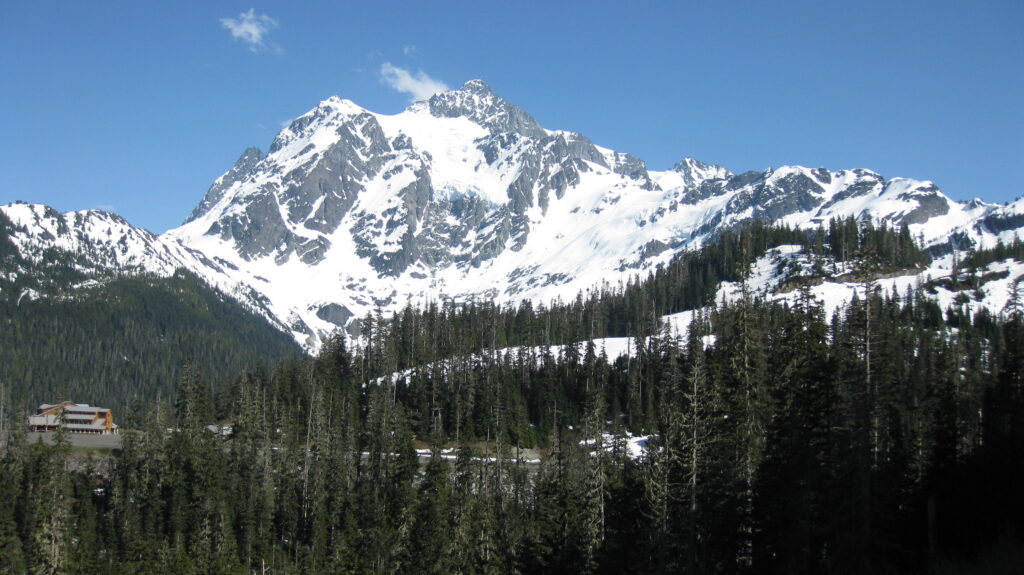
I could not stop staring at the mountain and taking photographs of it from every vantage point I could find at the Mt. Baker Ski Area. I ended up taking over 60 photos of the mountain that day. This ski area still had lots of snow covering the ground everywhere. It looked like a winter wonderland with Mt. Shuksan as the most iconic feature.
This was too beautiful a sight to share with myself. I called my mom and two female friends that I fancied at the time to share with them where I was and described to them what I saw.
The only thing looking odd was the reflection pond from my poster was missing. I then realized the pond was right in front of me. It was just buried under the winter snow and ice. A bit of the water was visible as the spring weather was melting back the frozen pond. Not seeing the reflection pond like my poster had me curious to return at some point to see Mt. Shuksan again.
The mountain ranges surrounding Mt. Shuksan wore impressive winter snowpacks. I marveled and took lots of photos of those mountains. I could see why North Cascades National Park was referred to as “The American Alps.” I never saw the Alps in Europe. However, these mountains were perfect to behold in my eyes.

Traveling across and back North Cascades National Park on May 31, and June 1, 2009
Around 7:30 pm I left the Mt. Baker Ski Area and started driving the switchbacks down the mountain. It was late May with still plenty of daylight, but I did not want to get back to my campsite in the dark. It was a 30-minute drive back to my campsite. I still found a way to visit the roaring and steep Nooksack Falls just after 8 pm with remaining daylight, located a few minutes’ drive from my campsite. I slept well that night with my dream come true of seeing Mt. Shuksan.
The next day, I drove south on Hwy 9 back to Sedro-Woodley. Near Acme, I had to slam on the brakes again and pullover to the side of the road to give another good view of the Twin Sisters Range. It was another clear sunny day to admire views of snow capped mountains.
At Sedro-Woodley, I headed east to drive on Hwy 20, which cuts through the bulk of North Cascades National Park. With many high snowy, jagged topped mountains, I thought this was one of the most spectacular national parks I had seen. By this point in my life as a seasonal park ranger, I had seen most of the U.S. national parks.
I spent the middle of the day hiking on Thunder knob Trail. It is 3.6 miles round trip and climbs 425 feet in elevation to a vantage point with scenic views of Diablo Lake and nearby snowy rocky top mountains. It surprised me to see visitors walking their dogs on this trail. I was on vacation, but I was still in my park ranger mode. I engaged visitors in a friendly way to let them know dogs are typically not allowed on national park trails. They smiled at me and kept walking their dogs. When I returned to the trailhead, I noticed they were correct and I was wrong. The trailhead sign said, “Pets are allowed but must be on a leash.” Actually, I was the idiot!
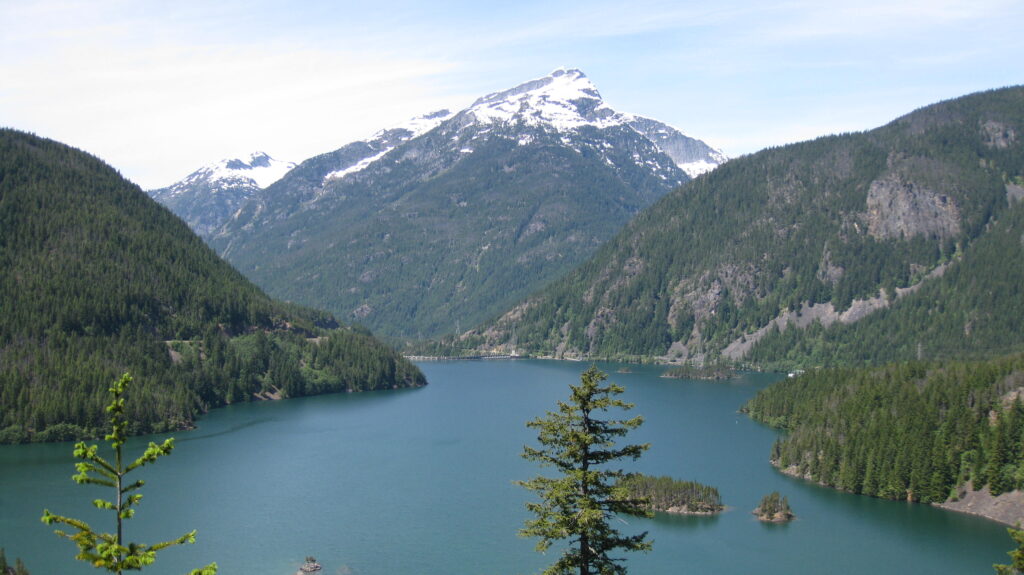
I camped that night at park Colonial Creek Campground, located directly across the road from the Thunderknob Trailhead. It was Saturday evening Memorial Weekend. The campground was crowded with loud families, but I was very happy to get a campsite for the night. The next day I drove east on the North Cascades Highway with another day of perfect weather to see magnificent snowcapped mountains lined up along the sides of the highway. I stopped frequently to take photos and admire these splendid mountains.
At one of the pull outs, I encountered some friendly Grey Jays. Years ago,a fellow Crater Lake Park Ranger told me that if one reaches out their hand, a Grey Jay (also known as a Canada Jay) might land on it. For the first time in my life, I extended my hands. A friendly Grey Jay landed on my hand! It felt magical. Of course, it was probably fed by another tourist in the past and was simply looking for a food handout from me. From all my years of working in the national parks, I was not going to give this bird food. Thus, the bird soon flew away from my hand.
I would have never done this trick at Crater Lake National Park in uniform because it would have encouraged other visitors to interact with the animals and feed them. Nor would I have done this out of uniform because other park ranger would have probably scolded me for engaging with the wildlife. However, this was fun to interact with this Grey Jay away from Crater Lake and at a location where there were no other park visitors around at the moment.
I made it to Winthrop, Washington late afternoon. It’s a lovely old west themed town that thrives on tourists staying there on their way to the outdoors. The gift shops and restaurants are scrunched together like a set from an old western film. It has a fun mountain town themed vibe to get a cup of coffee, eat dinner or buy some artistic souvenirs. I found a comfortable motel to spend the night. It was my first shower after a week of camping. I felt bad for the people who encountered me the previous days.
The next day, I could go anywhere, but I decided to travel back through North Cascades National Park on another warm sunny day. Mt. Shuksan was calling me to visit again. As I approached Glacier, Washington, there was excellent visibility to see Mt. Baker. Thus, it looked to be another day with an outstanding view of Mt. Shuksan if I could make it up to the Mt. Baker Ski Area late in the afternoon. I found another campsite at the Douglas Fir campground near Glacier, Washington. I headed up to the Mt. Baker Ski Area by the early June summer evening.
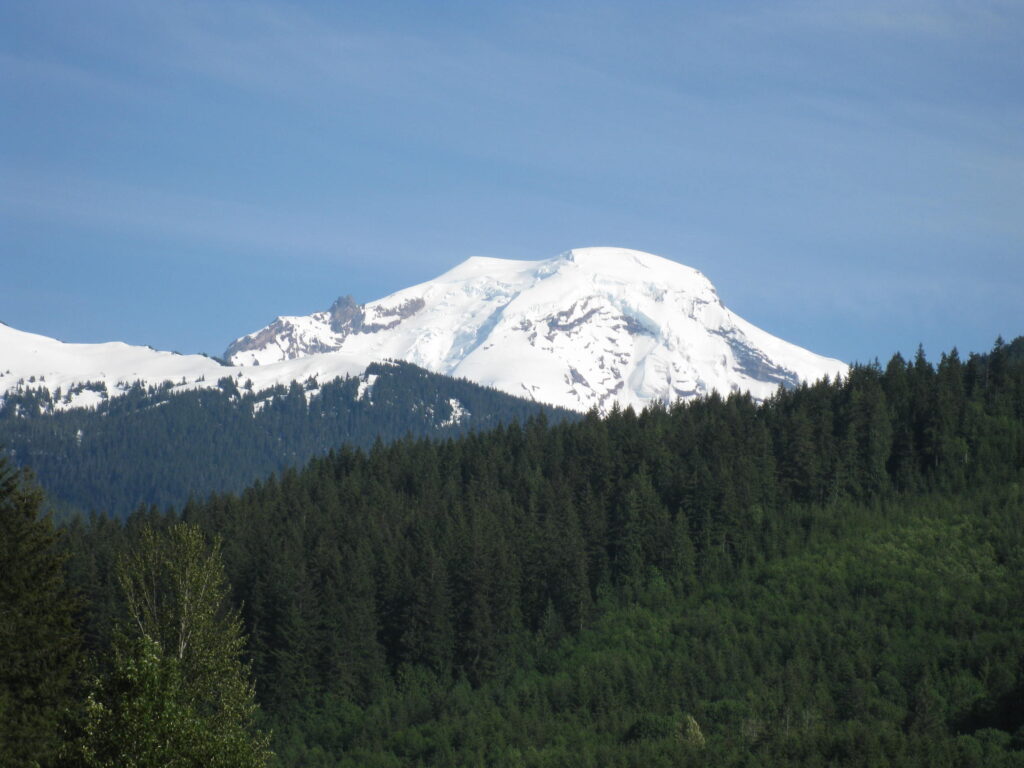
Seeing Mt. Shuksan for the second and third time in early June 2009
This time, Mt. Shuksan looked more amazing. Picture Lake had no ice or snow on it. No wind was blowing. The mountain had a perfect mirror reflection, even better than I remembered from my childhood poster. Two other photographers were there to capture that perfect image of Mt. Shuksan with the mirror image of it reflected in Picture Lake. I once read that Mt. Shuksan is the most photographed mountain in the world. I saw why from this moment.
I got the ideal photo of Mt. Shuksan with my digital camera. Years later, my father-in-law helped me frame a large image of my photo. That picture of Mt. Shuksan is my Facebook banner photo since I joined Facebook in 2009. It is the most stunning image I have seen in my life. It is the first photo on this blog.
The next day, I rented a pair of snowshoes in Glacier, Washington to explore around on snowshoes in the Mt. Baker Ski Area. I hiked in the snowshoes up to Artist Point to get fantastic views of Mt. Baker and Mt. Shuksan. Both mountains were absolutely shining in their winter snow white on clear early June day. Not a cloud was in the sky. Just the sun shining strongly with the bright light bouncing off the snow at the ski area to give me snow blindness late that afternoon. My eyes really stung from the intense daylight that day.
Yes, my eyes hurt so bad afternoon from the snow blindness. At the same time, I was surrounded by magnificent snowcapped mountains in every direction while I happily traversed around on snowshoes. It was one of the best days of my life! I was so lucky to be alive to experience the Mt. Baker Ski Area and all the mountains around me covered in deep winter snow. Except for a few other people, I had this area to myself. I loved taking numerous photos to capture the awesome beauty that day. I was very proud of my digital photos looking at them afterwards and today. At the same time, the photos could not capture my pure joy of being there that day.
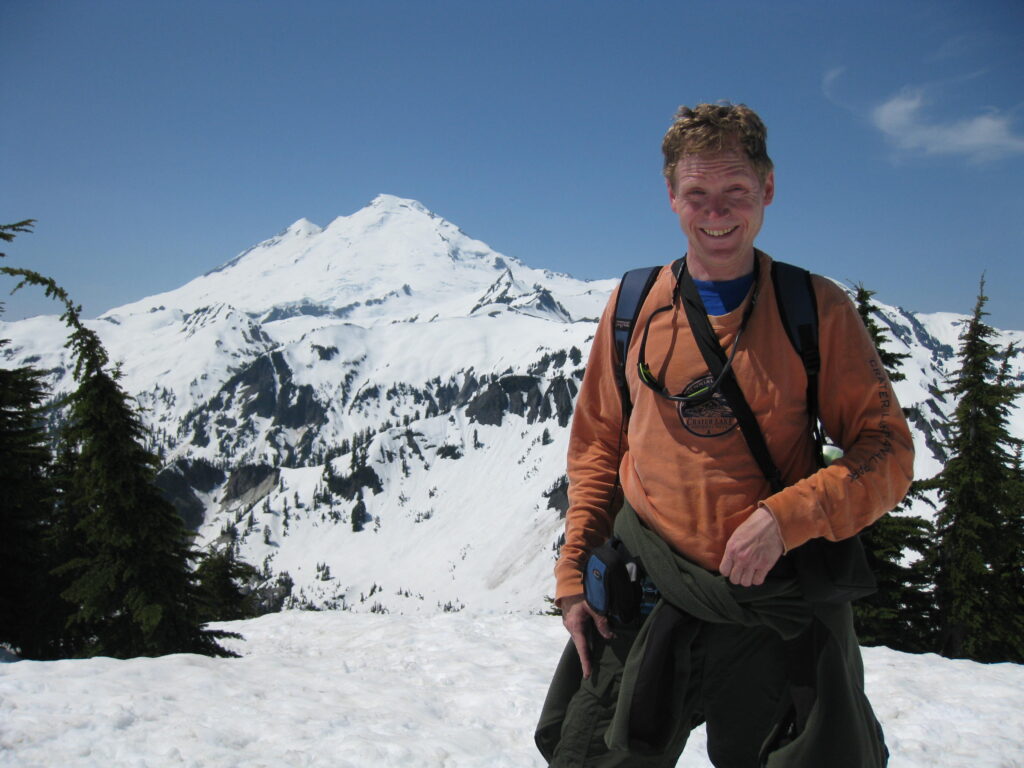
Visiting Mt. Rainier National Park in early June 2009
The next day, I left to explore Mt. Rainier National Park to camp there for two nights. During my stay at Mt. Rainier, the sky became overcast. I could still see Mt. Rainier because the clouds were high above the mountain. The overcast weather spoke clearly to me that I was very lucky to have clear weather for nearly the entire trip to this two week visit to Washington state. I had a terrific time hiking at Mt. Rainier to get views of this mountain in early May.
This was the era before smart phones and selfie sticks. It was the days when you would ask a stranger to take your photo at a scenic location. Well, I asked a stranger to take photos of me with my digital camera with Mt. Rainer in the background. This older gentleman did not listen to my instructions closely. He took good photos of me, but he did not know how to get Mt. Rainier in the background of my photos. Thank goodness, nine years later, I had an iPhone, and I could use it to take selfies of me with iconic scenery such as Mt. Rainier centered in the background.
When I strolled by the Paradise Inn, I had a good look at a Cascade Red Fox. It was standing there in the snow watching the visitors walk past him. This fox looked tame like a person fed it recently. It hoped someone else would give it some food. It stayed in the same spot for a long time allowing me to take numerous photos of it with my camera. It almost acted like it was posing for the cameras, like a fashion model, as if this was another tactic to get a free meal.

The next day was clear with an ideal blue sky and the mountain was totally visible. I choose to hike that morning on the Rampart Ridge Trail, which starts at the lower elevation Longmire Visitor Center. As I neared the top of the loop, I had terrific views of Mt. Rainier. There were still patches on snow on the trail now and then, which made it more challenging to follow. It created a sense of fun to locate the trail when it was obscured by the snow now and then.
Returning to the Longmire Visitor Center in late afternoon, I got sunscreen in my eyes somehow. Ir was stinging and causing a lot of discomfort. As I was headed to the men’s room to use the sink to wash the sunscreen out of my eyes, I ran into someone I knew. Her name is Jennifer. She used to work seasonally on the trail crew at Crater Lake. She was quite friendly when she saw me. I always thought she was very attractive, but out of my league.
Jennifer had a sharp wit. She was a master of using a wide variety of manly tools. I had neither of those skills. She was captivating with her long straight blonde hair, enchanting smile, great buff figure from working on outdoor trails, and a very charming personality. We did not know each other well, but we enjoyed saying hello to each other when she worked at Crater Lake. She was someone you would want as a friend and would be honored to date.
Sadly, when I saw Jennifer, my eyes were super irritated with sunscreen. We said hello to each other and tried to strike up a conversation about what each doing these days. However, my eyes kept constantly blinking at her since they were feeling miserable in that moment. I looked like a complete loser with my eyes rapidly blinking at her. I was unable to look at her because it was hard for me to see and keep my eyes open. It was a very awkward moment. I had to cut the conversation short to run to the bathroom to flush out my eyes in the sink. When my eyes returned to normally, I went back outside to try to chat with her again. However, she was gone. She was probably onto her next trail work assignment for the day.
Fortunately, when I saw Jennifer months or years later, I was able to explain what happened. She laughed. Jennifer always looked for the positive and the goofiness in everything. She responded that she figured that I had something wrong with my eyes in the moment. She did not take it personally that I was constantly blinking at her. Whew! That was a relief.

After visiting Mt. Rainier for a couple of days, I stayed a couple of nights with Scott and Nikki in Grapeview again. Then I visited again with my friends Gary and Melissa Martin and their daughter Shelby in Salem, Oregon. I was so eager to show my friends my digital photos from my trip seeing the mountains of Washington.
That weekend, I returned to Crater Lake for the summer to start work on Monday, June 8th.
Seeing Mt. Shuksan together with my wife Tanya for the first time on September 2, 2018
I never forgot about Mt. Shuksan. My wife, Tanya, and I moved to Portland, Oregon in February 2017. I showed her my favorite mountain on Labor Day weekend 2018. She did not say much about Mt. Shuksan. She is not as chatty as me. She did give me the impression that she enjoyed seeing the mountain because she took lots of photos. She has been open to traveling to see the mountain again when opportunities happened.
When we saw the mountain together for the first time on September 2, 2018, a thin ban of clouds wrapped just underneath the summit and shrouded the top of the southern part of the mountain. The clouds blended into the mountain well on this partly cloudy day. I was a tad disappointed that the ban of clouds hid a bit more of the top. I wanted Tanya to see the mountain unobstructed by clouds, like the first time I saw it. However, she was fine seeing the mountain as it was that day and slightly annoyed with me with my frustration of wanting perfection.
The Mt. Baker Ski Area looked different in September 2018 than what I remembered in the beginning of June 2009. All the winter snow that I saw in June on the ground and clinging to the mountain was not there. Just the glaciers were clinging to the mountain. The summer green grass and exposed ground made a nice contrast to the blue sky and dark rocky mountain. The deep winter snow that I saw in June 2009 with all its bright whiteness made for dramatic scenery and stellar photography.
I said to Tanya that I hope we can go to the Mt. Baker Ski Area sometime in early June so she could see what I first experienced seeing the mountain for the first time. Again, she enjoyed what she saw that day. She did not want to hear about what I thought she was missing.

Having said that, it was still spectacular to see Mt. Shuksan at the beginning of September and finally have the chance to show it to Tanya. The good news is that the clouds on the mountain dissipated by early evening. Thus, Tanya and I were able to see totally clear views of the mountain. Tanya got to see firsthand why this is my favorite place on planet Earth. She seemed to deeply appreciate this location and our time together there.
Seeing Mt. Shuksan with Tanya and her parents on August 11, 2019
Tanya’s parents, who live in St. Louis, heard me talk about Mt. Shuksan so much that they wanted to see my happy place. In early August 2018, my in-laws came to visit us in Portland in early August 2019. They then went to a folk-dance camp in near Tacoma, Washington for a week. After that week was over, they decided they would meet us at the Douglas Fir Campground near Glacier, Washington. This was the same campground I stayed when visiting the Mt. Baker Ski Area for the first time in 2009. Tanya and I stayed there on Labor Day Weekend 2018 when she saw Mt. Shuksan for the first time.
Tanya and I left Portland two days before meeting up with them. We drove up central Washington to spend the night in Winthrop, Washington. We then spent the day driving through North Cascades National Park so she could experience that national park for the first time. It was overcast driving through the park that day with the clouds covering the tops of the mountains. Still, some of the mountains on the east side of the park were completely visible to see.
As we drove through the park, we took lots of photos and did the short hike on the Thunder Knob Trail. The wind blew briskly that day, so the air had a bit of coolness to it. We hiked on this trail to see the light bluish green turquoise hue of the waters of the manmade Diablo Lake. This body of water straddles between the steep forested lower elevation mountains you see on the North Cascades Highway as it winds through the national park.
All four of us were happy to meet up at Glacier, Washington Forest Service Campground late in the afternoon on August 11, 2019. It was still very overcast, and Mother Nature decided not to burn off or push away the clouds that day. As we drove into the town of Glacier, we could not see Mt. Baker off in the distance behind the front range of mountains. The overcast clouds hung so low to block mountain views. From my experience visiting the area, my gut feeling was that if Mt. Baker was not visible, Mt. Shuksan would not be either.
My father-in-law, Rex, was like a kid on Christmas morning, eager to make the 40-minute drive to see Mt. Shuksan from the campground. It was almost 5 pm in the afternoon. I was not in a rush to see the mountain since the overcast skies indicated Mt. Shuksan was probably not visible. In addition, the three restaurants in Glacier seemed to shut down by 8 pm. I advised to eat dinner first, then drive up to see if the mountain was visible. Rex was still singularly focused on viewing the mountain and was resistant to my advice to wait until after dinner to see it.
Fortunately, Tanya and my mother-in-law, Nancy, were on my side. Rex was outvoted and Nancy made it clear to him that he was not going to win this argument. Thus, we had a lovely dinner at the Italian Restaurant in Glacier. We then made the 40-minute drive up to the Mt. Baker Ski Area, arriving around 8:15 pm. It was summer, so there was still plenty of daylight. However, my suspicion was correct. The upper half of Mt. Shuksan was covered in clouds. It was still great to see the lower half of the mountain with glaciers and patches of snow showing among the dark mountain face. However, it was not as fabulous to see as a clear day unobstructed by clouds.
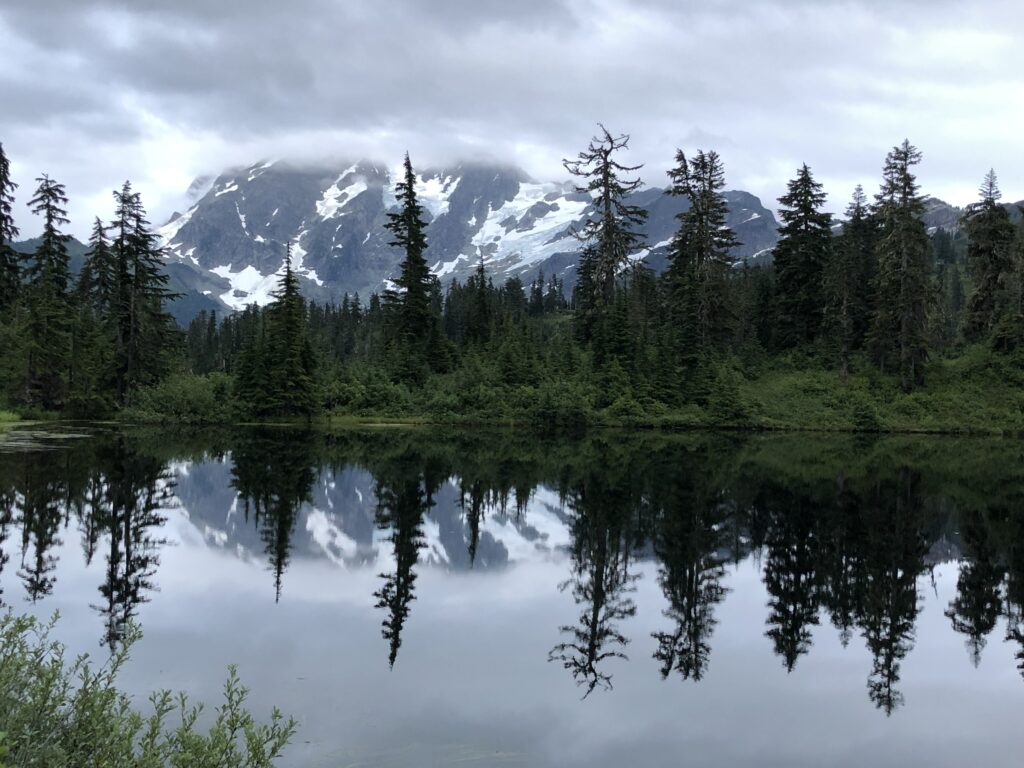
The next day, Tanya and I drove from Glacier, WA back home to Portland, OR. It was a bright sunny day with a perfect blue sky. We did not have a chance to see Mt. Shuksan that day. We were good with that since we saw the mountain on previous visits. Tanya and I were anxious for her parents to see it. They had the time to drive up to the Mt. Baker Ski area on August 12th and they did get to see amazing clear views of the mountain.
Rex and Nancy had a fulfilling day hiking by the Heather Meadows Visitor Center. Rex took lots of photos of the mountain and wildflowers on the Bagley Lakes Trail. Nancy shared that she enjoyed the hikes, the views, and wildflowers in Heather Meadows. Tanya and I were thrilled they got to explore the Mt. Baker Ski Area on a clear day and see is one of our favorite places.
Seeing Mt. Shuksan with Tanya on Labor Day, September 2, 2019
For Labor Day weekend 2019, Tanya and I had fun visiting Vancouver, Canada. I played clarinet in my high school symphonic band in St. Louis, Missouri in the 1980s. In 1986, our band instructor arranged for our band to visit Vancouver, British Columbia to play at the Expo World’s Fair. This was my first time seeing the Pacific Northwest and I knew then I wanted to live there someday. The city looked magical with a density of high rise buildings nestled up to a wide harbor and towering snowcapped mountains rising above the other side of the water.
I always wanted to return to see Vancouver, British Columbia. Portland, Oregon is about a 6 hour drive to Vancouver, BC. Living in Portland gave Tanya and I an opportunity to drive up there on a long 3-day weekend, such as Labor Day weekend. We had fun walking all around the city on Sunday, September 1st. The city was even more delightful than I had remembered as we took in the most scenic spots. We wore ourselves out that day walking in Stanley Park, driving in the park to see the Lion’s Gate Bridge, going to the top of the Vancouver Lookout building to get a bird’s eye view of the city, and wandering around to find the old Expo 86 location.
Labor Day was the day for us to drive back from Vancouver, British Columbia to Portland. However, we woke up to a clear day in Vancouver. With weather that optimal, we had to take a short drive out of the way to see Mt. Shuksan. We drove east of Vancouver to the Sumas, Washington international border crossing. Sumas is located an hour drive from the Mt. Baker Ski Area. The U.S. customs officer questioned us why were re-entering the U.S. through Sumas and not Blaine, WA, where we left the U.S. to go to Vancouver, BC two days prior.
My answer: “Because we want to see Mt. Shuksan.”
The U.S. Border Officer did not say another word and let us back in the U.S.
Tanya and I made it to Mt. Baker Ski Area in early afternoon to see at Mt. Shuksan at Picture Lake around 11:30 am. It was a glorious a mostly clear summer day with a small cloud rising over the backside of the mountain. We then drove to the end of the road at Artist Point to get splendid views of Mt. Baker and clear views of Mt. Shuksan.

At 2 pm, we left Artist Point to start the drive back to Portland. We made it back home after 9 pm that evening. We were exhausted from the drive, but high on seeing my friends, Mt. Shuksan and Mt. Baker, again.
Meeting up with my friend Mark Deeter in Seattle, WA in late July 2021
In mid-June 2021, I received a Facebook message from my friend, Mark Deeter. I worked with Mark in the Everglades in 1993 and Death Valley National Park in 1994. Mark lives in Cincinnati, Ohio. He wrote he planned to travel to Seattle, WA at the end of July on a business trip and he hoped to meet up with me. I had not seen Mark in almost 30 years, so I wanted to catch up with him. On July 12th, I purchased my train tickets to rendezvous with him in Seattle.
Mark would be off work July 27th and 28th, so we then started brainstorming for what we could do on his days off work. Mark likes to scuba dive, so he was thinking about doing that when he came to Seattle. I had never heard of scuba diving near Seattle. I told Mark that I don’t like to scuba dive. I don’t like the thought of being completely submerged underwater. I explained that if he wanted to scuba dive, I would be happy to watch him do it, but I would not be scuba diving.
Mark then suggested renting an airplane instead of diving, since he is a licensed small aircraft pilot. I responded that “We could rent an airplane if you can reserve one. I would love to see WA state from the air. Keep in mind that there are forest fires in the northwest right now, so it might be hazy when you come out here.”
I was not sure about flying in a small airplane. I enjoy flying. However, if the weather is clear, my favorite activity is day hiking in a national park or wilderness area. For whatever reason, Mark did not bring up the idea of flying again.
I traveled by train in Seattle on July 26th. I love riding in trains, and I have been on that scenic train ride several times from Portland to Seattle. That particular day, it was clear with good visibility to see Mt. Rainier. I snapped a good photo of it just south of Tacoma.
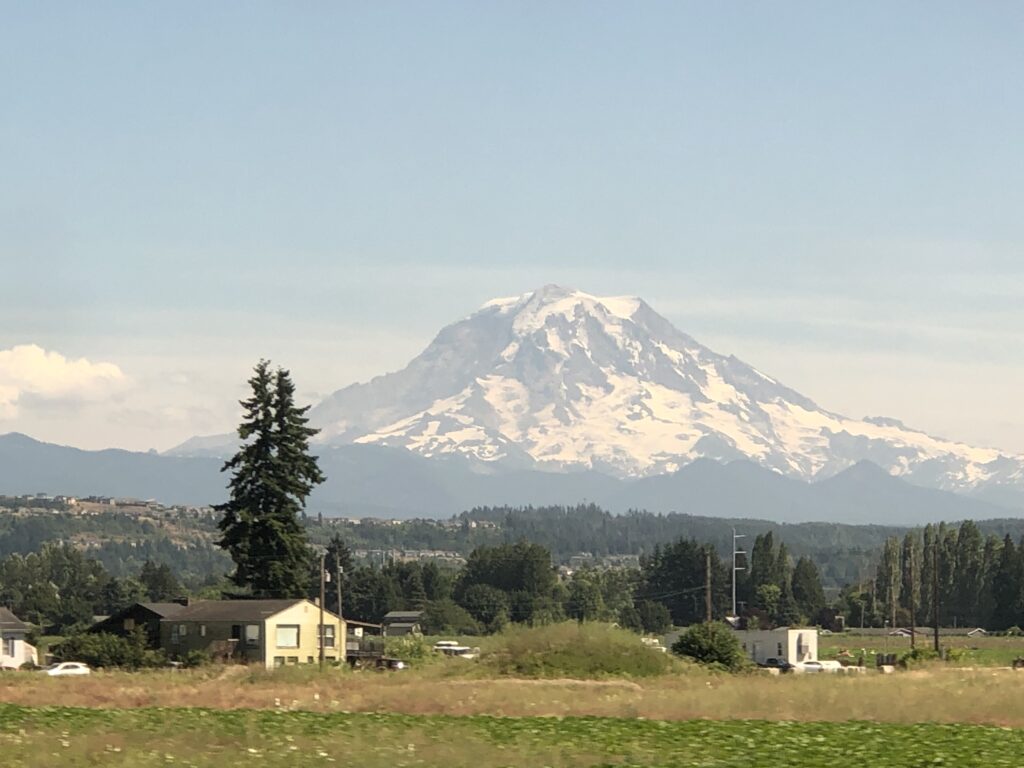
When I met up with Mark in Seattle that evening, we had not figured out what we planned to do yet during our two days together. I had very clear ideas. I wanted to spend one day driving up to the Mt. Baker Ski Area to see Mt. Shuksan and spend the other day hiking in Mt. Rainier National Park. Mark and I enjoyed hiking and exploring the national parks when we worked together in the Everglades and Death Valley. Thus, Mark was open to my ideas.
On July 27th, we woke up mid-morning from the cheap motel he stayed at in Bellevue, WA with the intention to go to the Mt. Baker Ski Area. We ate breakfast at a place that caught my attention that we drove by the day before, Chace’s Pancake Corral. I thought the banana pancake breakfast was delicious. I ended up having that breakfast all three days of my trip.
Mark then drove us to a nearby REI where he bought a new backpack. He then drove us in his rental car towards the Mt. Baker Ski Area. I knew the exact and most scenic route to take to reach our destination. It was less than a 3-hour drive from Bellevue to the Mt. Baker Ski Area.
Seeing Mt. Shuksan with my friend Mark Deeter on July 27, 2021
When we reached northern Washington town of Burlington on I-5, the GPS wanted to route us a different way. It was after 1 pm and I did not have time to think about that then. Mark and I stopped at a Subway to use the bathroom, stretch our legs, and buy lunch sandwiches for the road. However, I routed us to take state Hwy 9 north of Sedro-Woolley to Maple Falls and then take state Hwy 542 to arrive at the Mt. Baker Ski Area.
Around 1:40 pm, we reached the scenic pull off on Hwy 9 near Acme, WA. Just like I saw 12 years earlier, to the east, I saw the majestic jagged snowcapped mountains of the Twin Sisters Range with snowcapped Mt. Baker peaking out just to left of those front range peaks. Mark marveled at seeing this view. We felt lucky to snap pictures of this scene on this marvelous summer day.

That jubilation only lasted for about a minute. When Mark drove a few hundred feet up the road, he slammed on the brakes. A giant barrier blocked the road announcing, “Road closed for construction.” No wonder the GPS would not guide us up Hwy 9! Mark and I backtracked and found other roads to take us to Glacier, Washington and onward to the Mt. Baker Ski Area.
Mark drove on backroads on Whatcom Lake, which lies directly west of Acme. Whatcom Lake looked like a mini-Lake Tahoe with fancy big homes and highbrow boats on the water. We ended up in the outskirts of Bellingham, WA. We finally connected with state Hwy 542 to drive east towards Maple Falls, Glacier, and then the Mt. Baker Ski Area. We got a peak of Mt. Baker by Maple Falls after 3 pm, so we knew this was a good day to try to see Mt. Shuksan and Mt. Baker.
I was anxious to get to our destination. However, Mark spotted the sign for Nooksack Falls, so we had to stop there. These are stunning waterfalls to see, so I did not blame Mark for wanting to stop there to check them out. After the brief waterfalls stop, we were back in the car to head to the Mt. Baker Ski Area.
We finally reached Picture Lake with fantastic views of Mt. Shuksan after 4 pm. We now had time and were relaxed enough to eat our Subway lunches while admiring the view of Mt. Shuksan. It was great to get a selfie with Mark there on my iPhone. This was the only selfie with him during this trip. We then got back in Mark’s rental car to drive to Artist Point.

When we reached the Heather Meadows Visitor Center just a mile up the road, we discovered another barrier. The road to Artist Point was still closed for the season. There were still patches of snow on the road past that point that made it unsafe to drive.
Mark and I decided we were not going to miss Artist Point with the views of Mt. Baker and Mt. Shuksan. The only option was to hike the Wild Goose Trail, which is over a mile long with an elevation gain of 800 feet to reach Artist Point. Oddly, I intended to go hiking on this trip, but I did not pack my hiking boots or trekking pools. I just had my comfortable blue tennis shoes that I use for walking in urban areas. The soles have no grooved trend on the bottom to grip elevated rocky, soft dirt, or muddy hiking trails. These shoes were very light weight though, which made me feel like a nimble mountain goat.
Hiking up the Wild Goose Trail quickly, I made it to Artist Point around 5:40 pm. I had to wait a while for Mark. He was not used to hiking, especially on a trail let with a higher elevation that was steep in spots. As always, the scenery at Artist Point was beyond words. It was late in the afternoon. The sun’s position put Mt. Baker in poor lighting. The best lighting for Mt. Baker is in the mornings where the sun in the east would cause the snow on the mountain to glow brightly.
On the other hand, the late afternoon sun had Mt. Shuksan perfectly lit. The dark mountain rocks and the glaciers with the patches of snow on top all shined brightly this time of day. As usual when I visit Picture Lake and Artist Point, I cannot take enough photos of Mt. Shuksan.
Mark was ecstatic to be at Artist Point among all this mountain scenery. We nearly had the area to ourselves, except for a few other pleasant tourists admiring the view from this location. Coming from Cincinnati, Mark was astonished to still see snow on the ground this time of year. He asked a friendly older couple to film us having a snowball fight. I immediately said “No!” and put an end to that idea. I worked at Crater Lake National Park as a park ranger for 25 years. It was not unusual for me to see snow on the ground at the end of July. I just wanted to take in the sacred beauty all around me and not play with snowballs at that moment.
We then started down the Wild Goose Trail back to where Mark’s rental car was parked at the Heather Meadows Visitor Center parking lot. It was Tuesday, mid-week, going into the evening. We encountered very few people that day at Picture Lake or Heather Meadows. The quietness of that area with the sometimes whisper of a summer breeze all felt so peaceful. This was another sublime experience to soak in the scenery at the Mt. Baker Ski Area. I was happy my friend Mark could join me. He felt bad he could not keep up with me hiking. On the other hand, Mark was as happy as a school kid starting summer vacation visiting that location. Both Mark and I are in our 50s but we felt as joyful as children to be there that day.

Around 8 pm, we departed the Mt. Baker Ski Area to drive down the mountain. We still had daylight to guide us, but it was dark when we reached Bellingham around 9:30 pm. We were eager to have a late dinner, so we stopped at the Applebee’s located next to I-5. We did not leave Applebee’s until around 10:30 pm for the hour and a half drive back to our motel in Bellevue. After we reached our motel room after midnight, Mark immediately went to bed. I stayed up for a bit feeling elated from seeing my favorite mountain, Mt. Shuksan, that day.
Seeing the Sunrise Area at Mt. Rainier National Park on July 28, 2021
Mark was moving slow the next day after all the driving and sightseeing we did traveling to the Mt. Baker Ski Area the previous day. Mark was curious for what I had in mind for this day as he was waking up. I had my sights set for going to Mount Rainier National Park to do more hiking and marvel at this mountain. In the 1990s, Mark worked at Grand Teton, Everglades, and Death Valley National Parks. Thus, Mark was agreeable to drive to Mt. Rainier.
For the second day in a row, Mark and I had breakfast at the Chace’s Pancake Corral. Like the day before, I filled myself up on the banana pancakes. Mark and I then drove south to Enumclaw, where we stopped at the Safeway to get food items to pack for an eventual lunch. We then drove to Mt. Rainier National Park, reaching the park boundary sign by 2:15 pm. Without knowing our destination, we ended up at the Sunrise area in the northeast area at Mt. Rainier National Park at 3 pm. Mt. Rainier looks massive at Sunrise.
It is called Sunrise, because as the name suggests, is also one of the first places in the park to capture morning’s early light. Thus, it’s best to go there in the early morning to have the morning sun behind you in the east shine brightly on Mt. Rainier as you look west towards the mountain. Mark and I arrived later in the afternoon eastern part of the mountain faced away from the sun, making it harder to photograph.
The scenery at Sunrise was incredible. It was a love at first sight for me. I brought Tanya there in October 2021 before it closed for the winter. We returned two times since then, including my birthday in July 2023. After Mark and I arrived, he decided we would hike the Mount Fremont Lookout Trail, which was 5.6 miles round trip with an elevation gain of 900 feet. I was totally up for this adventure, but I was not sure about Mark. He admitted to me he had not hiked much in years, plus he hiked much slower than me the day before at the Mt. Baker Ski Area.
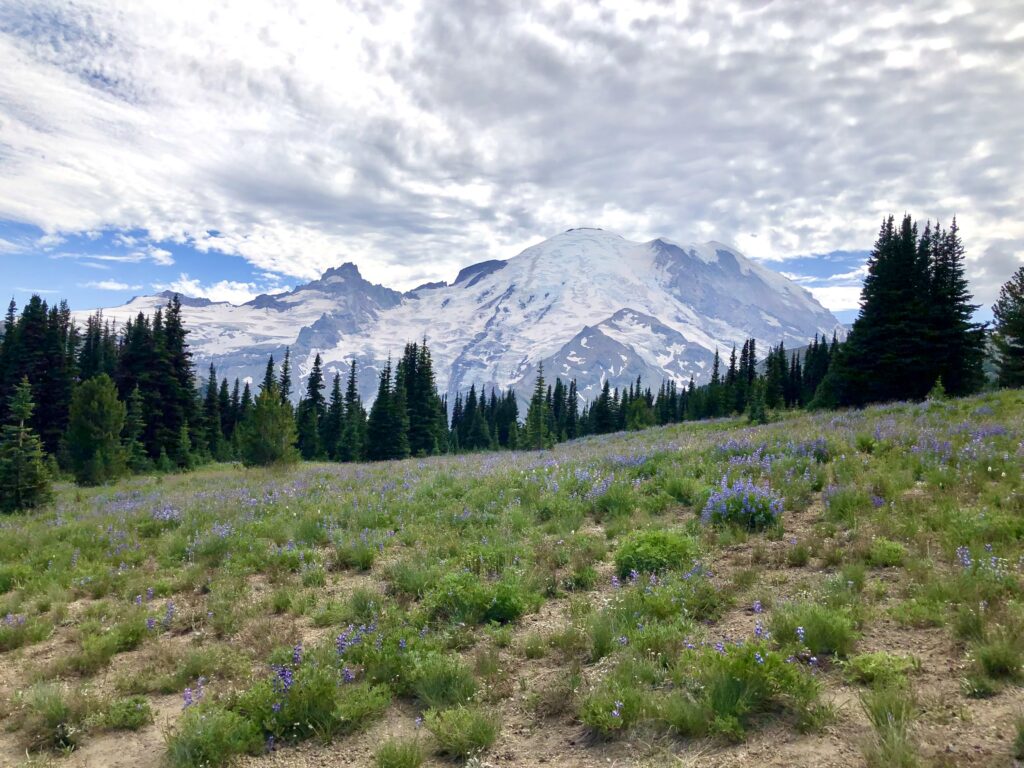
We ate our late sack lunch/dinner at 5 pm halfway along the trail. I reached the fire lookout tower at 6 pm. Mark was a half a mile behind me when I reached the Lookout Tower. I was there for around 15 minutes enjoying the view of Mt. Rainier and eating a granola bar before heading back down the trail. I ran into Mark on the way down the trail as he was making his way to the lookout tower. While I waited for him at the base of Mount Fremont, I saw a herd of mountain goats in that grassy valley. I pointed them out to Mark when he finally caught up to me.
We then hiked back to the Sunrise parking area around 8:40 pm. It was dusk with the sun getting ready to set anytime. As we drove away from the parking lot to head down the mountain, we saw a young male Black-tailed Deer that photographed .
We arrived in our motel room in Bellevue around 10 pm. The next day, I took the train home from Seattle to Portland. I will always be grateful to Mark for this great adventure to see the Mt. Baker Ski Area for my fifth time and discovering the Sunrise Area at Mt. Rainier for the first time.
Seeing Mt. Shuksan with Tanya and her Danish relatives on September 13, 2023
In September 2023, my wife, her parents, 8 of my mother-in-law’s Danish relatives, my in-laws’ best friends from St. Louis, and I met in Seattle so all 14 of us could see Glacier National Park, Montana. I shared details of this trip in a separate blog I wrote weeks after the trip, “Seeing Climate Change when I visited Glacier National Park.”
Towards the end of the trip, our group went to the Mt. Baker Ski Area to see Mt. Shuksan. I love seeing family and friends’ reaction when they see my favorite mountain for the first time.
We arrived at Picture Lake at 6 pm on September 13th. The late summer sun was low in the sky. As the sun was getting ready to set soon, it shined on just the upper half of Mt. Shuksan. As we gazed at the mountain, the sun’s path or a cloud moving out of the way, caused more direct light to appear on the mountain. The setting sun gave the mountain an amber hue. The orangish reddish glow on the mountain looked like it was heating up and going to catch fire any minute. Then the sun set and the dusk colors on the mountains slowly faded away.

As we were losing daylight, I entertained the group for a few minutes by inviting a Grey Jay to land on my hand. As the group was hanging close to the vehicles waiting for some of the hard core photographers in the group to wrap up their photos, I noticed a group of Grey Jays fly in to check us out. I then stretched out my hand to see if one would land on me. One Grey Jay did land on me. However, it got impatient expecting free food (which I did not have), so it bit my thumb. Sharp beaks these buggers have! It was painful for a moment and Tanya caught the bite on film. The Danish relatives thought it was funny. I was glad to bring more joy at that moment.
The next day, all 14 of us went to Artist Point to walk on the trails and get radiant views of Mt. Baker and Mt. Shuksan. Not a cloud was in the sky that day. With the sun shining brightly on these mountains, these wonders of nature looked like they wanted to show off how pretty they were on that day. Like any movie star wanting to be photographed, those of us who love to take pictures obliged these gorgeous mountains by taking countless photographs of them.
After lunch, half of the group returned to the giant rental house where we stayed in close to Glacier, Washington. The other half, including Tanya and me, hiked the Bagley Lakes Trail by the Heather Meadows Visitor Center. This loop trail is in a valley and follows the creek between the Bagley Lakes. Can’t see Mt. Shuksan or Mt. Baker from this trail, but it provided lovely views of a running creek with some colorful waterfalls along the way.
We finished this trail around 3 pm. It was time to start driving down the mountain so all 14 of us could have dinner together at our rental house. Before leaving the Mt. Baker Ski Area, Tanya and I made one last stop at Picture Lake to get final views of Mt. Shuksan.
The afternoon sun at 3:30 pm showcased the mountain in an exquisite way. If this was my final view of the mountain until a future visit, I left Picture Lake a very happy man indeed.
I now have lost track of the number of times I have seen Mt. Shuksan. I just need any excuse to go back there. So, now I am asking you: Would you join me on a trip to see Mt. Shuksan?
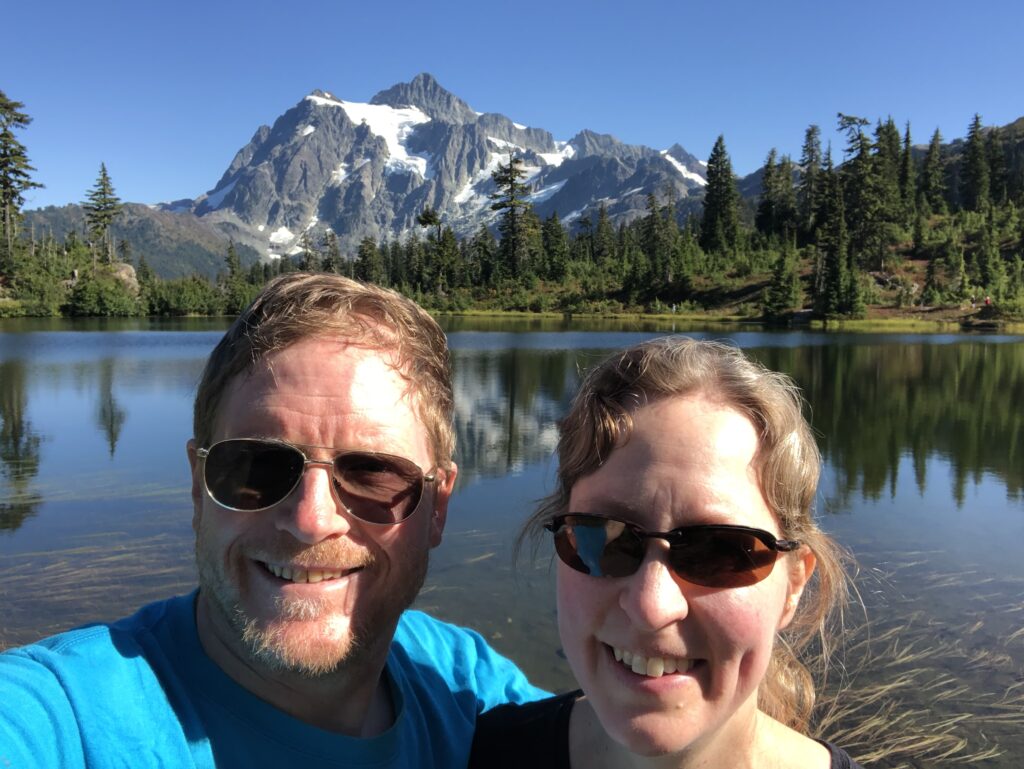
Mt. Shuksan inspires me to act on climate change and protect our planet
When I was a seasonal interpretative ranger in Everglades National Park from 2003 to 2008, I often shared this John Muir quote in my ranger talks, “Everyone needs beauty as well as bread. Places to play in and pray in where nature may heal and give strength to the body and soul alike.”
Over 1.3 million acres of Everglades National Park is designated as a wilderness area. The Wilderness Act of 1964 defines wilderness as “an area where the earth and its community of life are untrammeled by man, where man himself is a visitor who does not remain.” The purpose of this federal law is to preserve and protect the natural ecosystems and wild areas, provide opportunities for solitude, and retrospective or primitive recreation.
I used that John Muir quote and the definition of wilderness from the Wilderness Act of 1964 as a park ranger to stress that most of Everglades National Park was wilderness. Many of us don’t think the Everglades as wilderness. We tend to think of the old growth forests and the western jagged mountain ranges as wilderness. I wanted to expand their idea of wilderness and share the federal definition of wilderness for their understanding.
I am happiest in nature. Growing up in St. Louis, Missouri, I loved hiking as a child in nearby Bee Tree and Cliff Cave Parks along the Mississippi River. My passion for nature led me to work as a park ranger for summers at 25 years at Crater Lake National Park and winters 16 years in Everglades National Park. I never tired of hiking the mountain peak trails at Crater Lake. In the Everglades, I relished the amazing canoe trips and bird watching hikes.

Working in the national parks allowed me to visit other national parks. I made friends with rangers at Crater Lake and the Everglades who moved on to work in other national parks. Thus, I stayed with friends in Yellowstone, Yosemite, Sequoia, Grand Canyon, Capitol Reef, Canyonlands, and Hawaii Volcanoes National Park. One ranger friend invited me to hike to the bottom of the Grand Canyon twice. Another ranger friend, Pete Peterson, invited me to give a climate change presentation at Grand Canyon National Park.
Besides staying and visiting the national parks I listed in the previous paragraph, I had a life dream of seeing Glacier National Park. I finally saw it on a family vacation in September 2023. All these places make my heart sing and give me a spirit of renewal. I feel most alive in these places. Tanya and I have been married for over 8 years and together for over 10 years. She loves hiking, nature, and photography. Thus, it is fabulous to visit these places with her.
I love all the national parks I visited. I would jump love to visit any of them again. However, my favorite place is the Mt. Baker Ski Area to see Mt. Shuksan, as well as seeing Mt. Baker.
As I blogged previously, I started giving ranger talks in Everglades National Park in 1998. Back then, visitors asked me about this global warming thing which I knew nothing. I then started reading about the impacts of climate change on the Everglades and it scared me. By 2008, I quit my winter seasonal ranger job in Everglades National Park to start organizing for climate action. I then discovered that climate change impacted Crater Lake National Park. I started giving my climate change evening program there in 2011. In 2017, I stopped working my summer job at Crater Lake to try to transition to be a full-time climate advocate.
Even though I stopped working in the national parks, I still delight visiting those nearby. In 2017, Tanya and I loved visiting Mt. Rainier National Park together for the first time. We stopped by there on the way to visit friends in Washington state that weekend. The next day, Tanya dropped me off at a Climate Reality Training where I was a breakout speaker. It was a beautiful clear idea summer day in June with the sun shining very brightly overhead. In our excitement to see the mountain, we forgot to wear sunscreen. We planned to be there for a couple of hours.
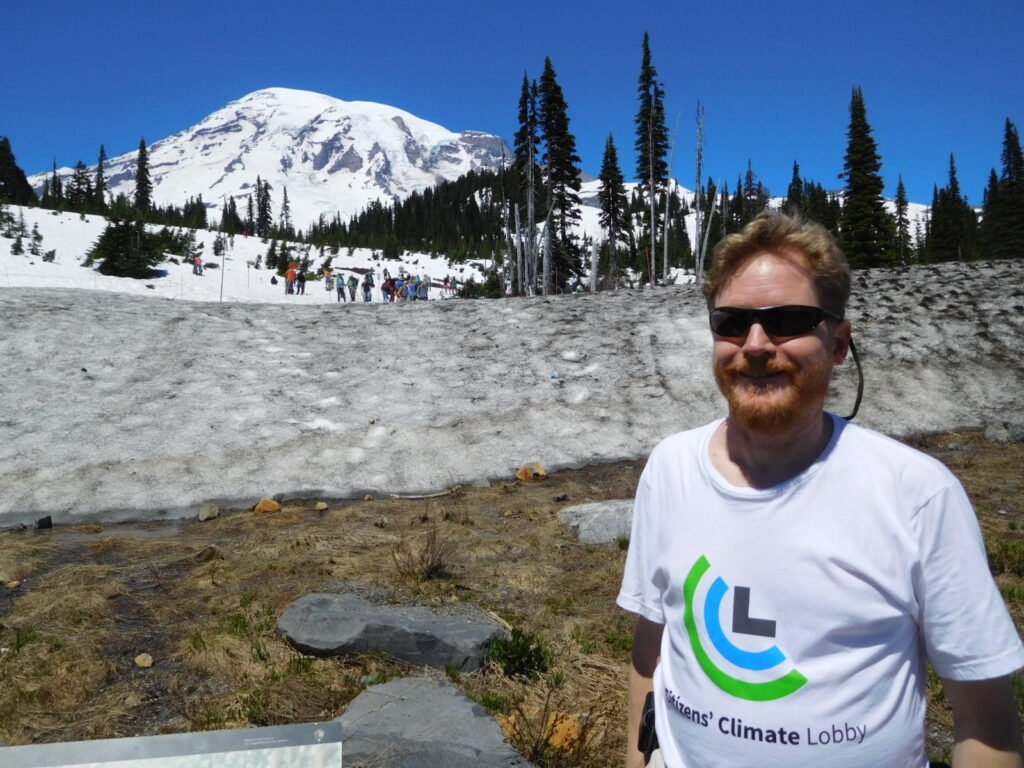
When I arrived at the Climate Reality Training the next day, my face was beat red like a lobster. My face hurt so bad that I had to keep applying aloe vera jell to my face. Fortunately, the redness of my face seemed to go down several notches by the time I spoke at the conference several days later. Even with that bad sunburn incident, Tanya and I returned to visit Mt. Rainier National Park several more times, especially to see it for my birthday in July.
In October 2021, Tanya and I visited Olympic National Park to see a ranger friend Steve and his family. In August 2022, Tanya and I, plus her parents, explored different areas of Olympic National Park while we visited my mother-in-law’s cousins in Sequim, Washington. As I wrote early on this blog, we had a big family trip to see Glacier National Park in September 2023. During this trip, we drove through North Cascades National Park to go visit the Mt. Baker Ski Area.
Since I stopped seasonally working as a ranger at Crater Lake in September 2017, I travel now to national parks for inspiration, relaxation, and renewal from my full-time climate organizing. Sadly, the national parks continue to remind me that they are negatively impacted by climate change. When I visited Glacier National Park in September 2023, I was saddened I could not see any glaciers in Glacier National Park. I wrote two blogs about that experience, including “Glacier National Park’s fading glaciers calls for Climate Action.” More recently, I read documented evidence the snowpack and glaciers have receded on Mt. Baker in recent years.
From working in the national parks years ago to traveling to them to vacation now, I can’t escape from the reality that climate change is negatively impacting our national parks.
All these natural places inspire me to be a climate advocate. They continue to motivate me to protect the natural world from climate change harming these sacred places.
In October 2023, I wrote a blog, “For Climate Action, advice from a former park ranger.” In that blog, I shared about a pocket-sized card that I would give to park visitors at the conclusion of my Watchman Peak Sunset Hike. It was called “Ranger Brian’s Wisdom.” The card contained the combined advice of my mentor, park ranger Steve Robinson, and me.
If I could boil down the message from “Ranger Brian’s Wisdom” to this blog, I would say,
‘Find your Own Sacred Place –
For me, that’s the Mt. Baker Ski Area, with the views of Mt. Shuksan and Mt. Baker.
Keep visiting your sacred place for inspiration and renewal –
as I keep going back to the Mt. Baker Ski Area when the opportunity presents itself.
Then do what you can daily to take climate action to protect your sacred places and all humanity from the threat of climate change.’
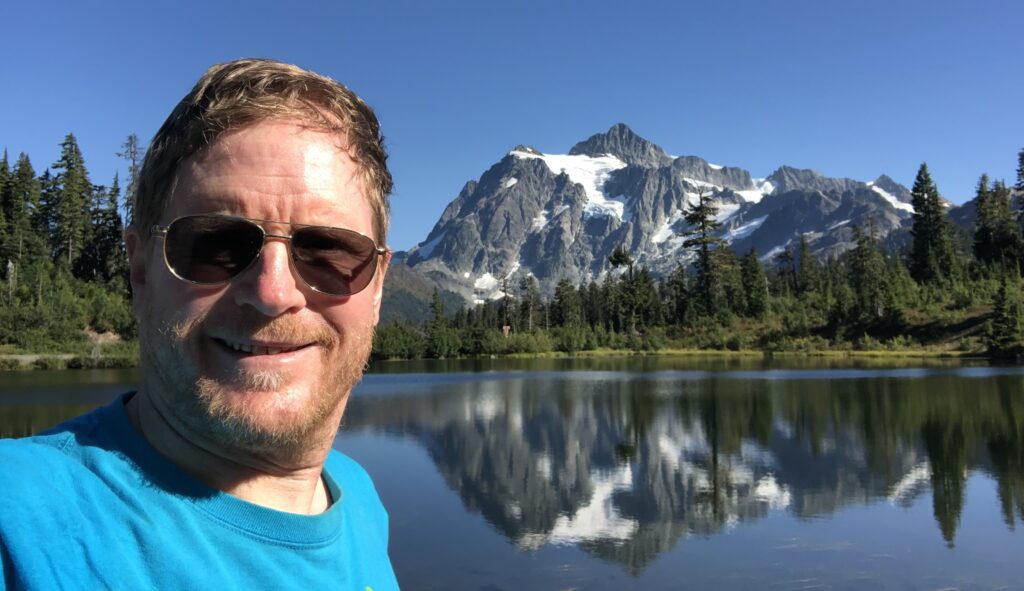
Who knows how my life would have been different, if I had not put the poster of Mt. Shuksan on my bedroom wall when I was in high school in St. Louis, MO in the 1980s.
